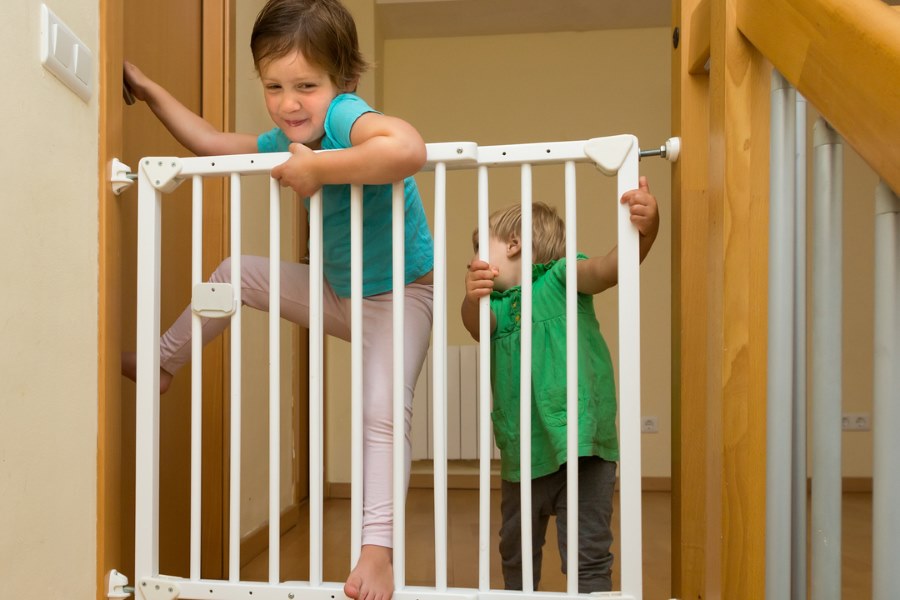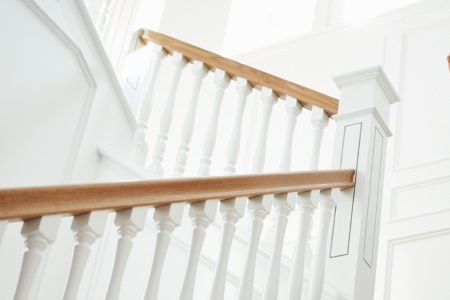More than one in five parents find staircases the hardest area to childproof

Family proofing your home isn’t always as simple as you may think. This was highlighted in a recent survey asking parents to pinpoint the hardest area in the home to address.
As expected, sharp corners proved to be the trickiest area to child proof, because apart from wrapping all furniture and fittings in bubble wrap, it is virtually impossible to smooth out every single hard or sharp edge around the home.
Childproofing staircases was the second most popular response, with 20% of parents admitting that this was a real problem area. The result came as a surprise due to the wide array of stairgates on the market; however, looking further into the reasoning behind this response it became clear that an alarming amount of staircases simply aren’t compatible with stairgates.
Ensuring that your staircases are safe is essential for all members of the family, but small children are undoubtedly more at risk of trips and tumbles. In fact, 58,000 children have accidents on the stairs each year, 35,000 of those being under the age of 4.
This leads us to the question…
Why exactly are staircases such a hazard?
The main reasons why staircases can present a danger to small children are:
- Poorly fitting stairgates don’t properly secure the staircase
- Flooring presents slip/trip hazards
- Balustrades and spindles can be in poor repair
- Staircases are made up of hard edges and sharp corners
…so, what can be done to make them safer?
1. Choose the right stairgate to fit your staircase
The main issue with stairgates is that there isn’t a one-size-fits-all approach. Different staircases will fit different gates; however, it is often a matter of trial and error finding the perfect stairgate to fit your staircase, and this can end up being a costly process with no guarantee of safety.
To find out more, we spoke to parents to work out why stairgates were proving to be such a headache…
Alexandra Hurton – creator of the Young Mummy Survival Guide – was happy to share her stairgate issues:
“I must say it's great to see this being addressed, it's an issue which can sometimes get lost in the world of parenting. We have gates at the top and bottom of the stairs. You have to think about what can happen when you're asleep. It's so easy for a child to climb out of their bed and you need to ensure they won't toddle off down the stairs!"
Donna - The London Mum went on to say:
”My biggest concern was making sure the child gate at the top of the stairs was able to withstand any force or weight my child put against it, while not damaging the walls or the surrounding wooden bannisters.”

Building regulations stipulate that the first two steps of a staircase (going up) do not require a balustrade, meaning that there can be nowhere to secure a stairgate to enclose the bottom two steps.
Before deciding on a stairgate it is well worth doing your research into the types of fitting that will work with your staircase configuration. Here is a breakdown of the different types of stairgates on the market and where they are best suited.
|
Type of stair gate |
Pros |
Cons |
Best for |
|
Pressure gate |
|
|
|
|
Fixed wall mounted gate |
|
|
|
|
Roller gate |
|
|
|
|
Foldable (self retracting) gate |
|
|
|

2. Address any slip or trip hazards
Falls in the home account for 44% of all children’s accidents. Four simple ways to help prevent slips and trips on the stairs are:
- Ensure carpet is securely fixed down and any frayed areas are repaired.
- Polished or painted stairs can be incredibly slippery underfoot, especially if you are wearing socks. Ensure that children either wear slippers or bare feet when walking on the stairs to help improve grip.
- Look at finishing polished or painted stair treads with a clear coat of non-slip paint or varnish.
- Don’t leave any objects on the stairs that could be tripped over.

3. Improve the overall condition of your staircase
Ensuring that your staircase is in the best possible condition will benefit all of the family, not just small children. Top things to look out for include:
Spindles - Make sure that spindles are secured firmly in place and they are correctly spaced so that children cannot fall through or get stuck between the bars. Building regulations specify that the gap between spindles should be no more than 99mms.
If any spindles are damaged, it is possible to replace them individually. If you can’t find a perfect match, exact replicas can be created by a reputable woodturning service.
Newel Post - The newel post is the thick post that is fixed at either end of the staircase to support the entire balustrade. Sometimes, especially in older properties, the newel post isn’t completely secure and may be slightly wobbly. Enlist the help of an experienced joiner or staircase specialist to advise you on the best way to fix it, as a loose newel can compromise the overall safety of the staircase. Under no circumstance should you secure a pressure gate to a loose newel post.
4. Protect sharp corners and hard edges
As the survey revealed, sharp corners can be a nightmare for parents. Obviously there are some protective measures that can be put into place around the home, but unfortunately due to their nature, staircases simply present corner after corner.
Ensuring that the staircase is securely cordoned off is clearly the ideal solution for protecting children from potential injuries; however, it is inevitable that they will have to be exposed to the staircase at some point.
Carpeting stairs treads is a good way to help soften sharp edges, and hopefully help towards preventing bumps, or if you are planning on replacing or refurbishing your staircase it may be worth considering replacing angular newel posts and spindles with more rounded designs, or even panels.

…and relax
At the end of the day, kids will be kids, and no matter how much you try to safety proof your home you cannot physically protect them from all eventualities. Following the above advice, however, will hopefully help tick off the main safety proofing issues, allowing you to relax in the knowledge that your home is as child friendly as possible, without a scrap of bubble wrap in sight!





